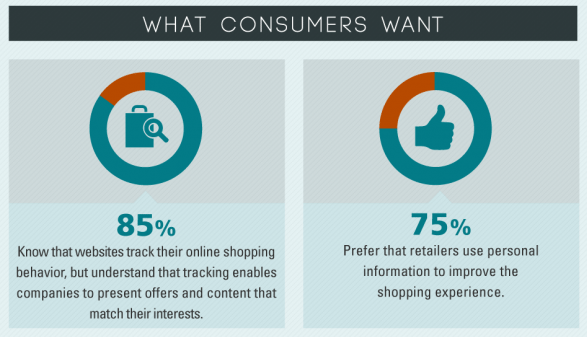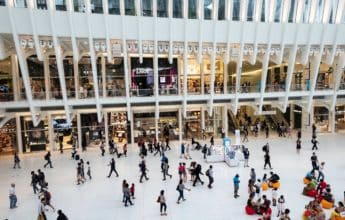Whether online, mobile, or in-store, customers expect a great experience. This is true for almost any industry, but in retail, where a well-rounded omnichannel path to purchase is becoming increasingly pervasive, experience is king.
The key to boosting the customer experience? Personalization.
On a high level, this means tailoring the service or experience you provide to specific individuals. This is easier said than done, especially as the relationship between retailers and their customers is becoming increasingly complex and the path to purchase involves more touch points. But personalization will be the way of the future as mobile continues to gain ground.
For our purposes, we’re going to talk specifically about retail mobile app personalization and how it will be a defining feature of successful retail mobile strategies.
Why Personalization?
Customer Expectation
Mobile technologies have transformed customer expectations in almost every industry, particularly in verticals like retail. Customers want convenience – instant access to information, ability to explore options, regardless of where or when. And importantly, they expect their experience with retailers, on any medium, to be relevant to them.
Image via TopRank Blog
Understanding of Buyer Behavior
Context is central to the shopping experience, and as already mentioned, the modern customer expects that their entire experience – search, recommendations, notifications, deals, and promotions, etc. – is relevant to them. Personalization offers the relevance that customers expect when shopping in a world where the experience is increasingly catered to individual preference and past behavior.
Simplify Path to Purchase
Personalization is meant to simplify the experience for the customer, which includes streamlining the path to purchase. Shoppers want to be able to buy using the payment method they prefer, at the time they want to, on the medium they prefer. This means retailers need to afford them the true omnichannel experience so a purchase is simple in-store, online, or on mobile.
Trends in Mobile Personalization
Personalization is not an easy feat, but the advantage of consumer-side technology improving is that enterprise-side technology has kept pace. The following trends are allowing retailers to leverage emerging technologies to personalize experiences for their customers.
Big Data
While experiences can be targeted based on contextual cues like location, past purchases, behavior, etc., true personalization requires data to drive the experience. Retailers have a rich variety of sources from which to collect data – mobile apps, site usage, social, locational, in-store behavior, email. Collecting, managing, and making this data actionable is a challenge that retailers are facing, but forward-thinking companies are already finding that committing resources to it is proving valuable.
Predictive Analytics
Predictive analytics are the result of big data made actionable. Data is not only collected but also contextualized and used to build predictive models that discover relationships and patterns between the historic data and outcomes in order to predict likely future behaviors; for example, when a shopper is likely to make their next purchase. Predictive analytics are being used to improve and refine many aspects of retail, from pricing to inventory control, customer service to revenue.
In-Store/Beacons
Beacons are fast becoming a highly effective and lucrative technology for retailers. Having hardware in-store that communicates with user devices provides an unprecedented ability to communicate and engage shoppers on a highly personal, contextual level. Already, retailers have found success using beacons to boost their sales, and with the technology expected to influence $44.4 billion in retail sales by 2016 (in the US alone), there is ample opportunity for retailers to get a piece of the pie.
Where Mobile Apps Fit In
Mobile apps can provide key insights needed to really nail down personalized customer experiences. They act as both a collection system for data and a delivery system for personalization initiatives based off of that data. Furthermore, they help retailers bridge the in-store and online experience, ensuring that shoppers receive the personalized experience they expect across all channels.
In-app behavior based on profile, purchase history, loyalty program data, and more can supplement online metrics (which can be eliminated when a user clears cookies) or traditional in-store metrics (which are useful on an aggregate level but not adequate by themselves to inform personalization) to provide a more holistic view of your buyers.
Mobile apps are also useful on an in-store level. They can help drive more sales and enhance the in-store experience through personalized customer engagement. Already, we’ve discussed beacons, which can communicate with a user’s device within stores, providing special promotions based on location, interests, and more. They also allow retailers to collect data into foot traffic, where customers are spending their time, how long they are spending in each section, and more.
Furthermore, statistics show that shoppers are already using retail apps during their in-store visits. More than half of shoppers who have retail apps use them while shopping in-store, for reasons like redeeming in-store discounts, finding products, and viewing product ratings and reviews. Leveraging the data collected about customers can help retailers personalize the in-app experience while shoppers are in-store, which can not only enhance the experience but streamline the path to purchase and drive in-store sales.
The New Shopping Experience
Customer expectations are shifting. Shoppers are creating their own omnichannel experiences, going online, using mobile apps, and visiting stores in their path to purchase. Increasingly, they expect their experiences to be personalized and relevant to them. Mobile personalization is a trend that retailers need to pay attention to. With the right mobile app strategy, you can connect with your customers on a personalized level across web, mobile, and in-store – not only to enhance the shopping experience, but also encourage loyalty, increase engagement, and ultimately drive sales.





